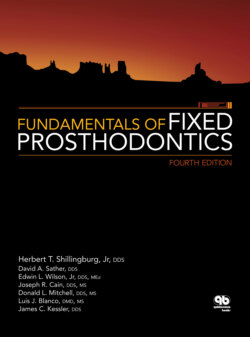Читать книгу Fundamentals of Fixed Prosthodontics - James C. Kessler - Страница 75
На сайте Литреса книга снята с продажи.
Anterior guidance
ОглавлениеThe mounted casts are examined on the articulator. Any nonworking interferences are removed from the casts so that the articulator can move freely while the anterior teeth remain in contact. If the guidance is inadequate for any reason, it is restored to an optimum configuration with a diagnostic wax-up.
The incisal guide pin is raised so that it will be at least 1 mm off the plastic incisal guide block in all excursions (Fig 5-51). Acrylic resin or a light-cured material (Triad) may be used. If a resin is used, the surface of the guide block is moistened with monomer. A half scoop of tray resin is mixed, and, while it is still free-flowing, a small amount is placed on the incisal guide. As the polymerizing resin becomes stiffer, more is added until there is about ¼ inch of it covering the guide block (Fig 5-52). The end of the incisal guide pin and all contacting surfaces of the anterior teeth are lubricated with petrolatum. The articulator is closed so that the teeth occlude completely. The guide pin will penetrate the soft acrylic resin (Fig 5-53). The articulator is moved through all excursions repeatedly, keeping the teeth contacting at all times (Fig 5-54). The tip of the guide pin will mold the acrylic resin to record the pathway of the various movements. The movements are continued until the resin is completely polymerized. The excess is trimmed off. A record of the anterior guidance has been formed on the incisal table (Fig 5-55).
Fig 5-51 The incisal guide pin should not contact the guide block.
Fig 5-52 Acrylic resin is placed on the incisal guide.
Fig 5-53 The guide pin is allowed to close into the soft resin.
Fig 5-54 The articulator is moved through all excursions.
Fig 5-55 An anterior guidance record exists on the guide block.
Fig 5-56 The components of a Spring-Bow are (left to right) the facebow with orbital pointer and the bite fork assembly.
Fig 5-57 The vertical rod of the bite fork assembly is inserted into the bow socket. The flat side is in front, with the empty bite fork clamp to the right.
